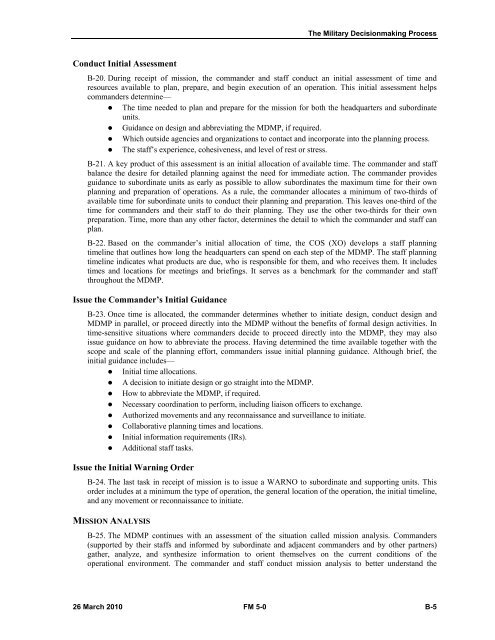FM 5-0, The Operations Process - Federation of American Scientists
FM 5-0, The Operations Process - Federation of American Scientists
FM 5-0, The Operations Process - Federation of American Scientists
You also want an ePaper? Increase the reach of your titles
YUMPU automatically turns print PDFs into web optimized ePapers that Google loves.
<strong>The</strong> Military Decisionmaking <strong>Process</strong><br />
Conduct Initial Assessment<br />
B-20. During receipt <strong>of</strong> mission, the commander and staff conduct an initial assessment <strong>of</strong> time and<br />
resources available to plan, prepare, and begin execution <strong>of</strong> an operation. This initial assessment helps<br />
commanders determine—<br />
• <strong>The</strong> time needed to plan and prepare for the mission for both the headquarters and subordinate<br />
units.<br />
• Guidance on design and abbreviating the MDMP, if required.<br />
• Which outside agencies and organizations to contact and incorporate into the planning process.<br />
• <strong>The</strong> staff’s experience, cohesiveness, and level <strong>of</strong> rest or stress.<br />
B-21. A key product <strong>of</strong> this assessment is an initial allocation <strong>of</strong> available time. <strong>The</strong> commander and staff<br />
balance the desire for detailed planning against the need for immediate action. <strong>The</strong> commander provides<br />
guidance to subordinate units as early as possible to allow subordinates the maximum time for their own<br />
planning and preparation <strong>of</strong> operations. As a rule, the commander allocates a minimum <strong>of</strong> two-thirds <strong>of</strong><br />
available time for subordinate units to conduct their planning and preparation. This leaves one-third <strong>of</strong> the<br />
time for commanders and their staff to do their planning. <strong>The</strong>y use the other two-thirds for their own<br />
preparation. Time, more than any other factor, determines the detail to which the commander and staff can<br />
plan.<br />
B-22. Based on the commander’s initial allocation <strong>of</strong> time, the COS (XO) develops a staff planning<br />
timeline that outlines how long the headquarters can spend on each step <strong>of</strong> the MDMP. <strong>The</strong> staff planning<br />
timeline indicates what products are due, who is responsible for them, and who receives them. It includes<br />
times and locations for meetings and briefings. It serves as a benchmark for the commander and staff<br />
throughout the MDMP.<br />
Issue the Commander’s Initial Guidance<br />
B-23. Once time is allocated, the commander determines whether to initiate design, conduct design and<br />
MDMP in parallel, or proceed directly into the MDMP without the benefits <strong>of</strong> formal design activities. In<br />
time-sensitive situations where commanders decide to proceed directly into the MDMP, they may also<br />
issue guidance on how to abbreviate the process. Having determined the time available together with the<br />
scope and scale <strong>of</strong> the planning effort, commanders issue initial planning guidance. Although brief, the<br />
initial guidance includes—<br />
• Initial time allocations.<br />
• A decision to initiate design or go straight into the MDMP.<br />
• How to abbreviate the MDMP, if required.<br />
• Necessary coordination to perform, including liaison <strong>of</strong>ficers to exchange.<br />
• Authorized movements and any reconnaissance and surveillance to initiate.<br />
• Collaborative planning times and locations.<br />
• Initial information requirements (IRs).<br />
• Additional staff tasks.<br />
Issue the Initial Warning Order<br />
B-24. <strong>The</strong> last task in receipt <strong>of</strong> mission is to issue a WARNO to subordinate and supporting units. This<br />
order includes at a minimum the type <strong>of</strong> operation, the general location <strong>of</strong> the operation, the initial timeline,<br />
and any movement or reconnaissance to initiate.<br />
MISSION ANALYSIS<br />
B-25. <strong>The</strong> MDMP continues with an assessment <strong>of</strong> the situation called mission analysis. Commanders<br />
(supported by their staffs and informed by subordinate and adjacent commanders and by other partners)<br />
gather, analyze, and synthesize information to orient themselves on the current conditions <strong>of</strong> the<br />
operational environment. <strong>The</strong> commander and staff conduct mission analysis to better understand the<br />
26 March 2010 <strong>FM</strong> 5-0 B-5















